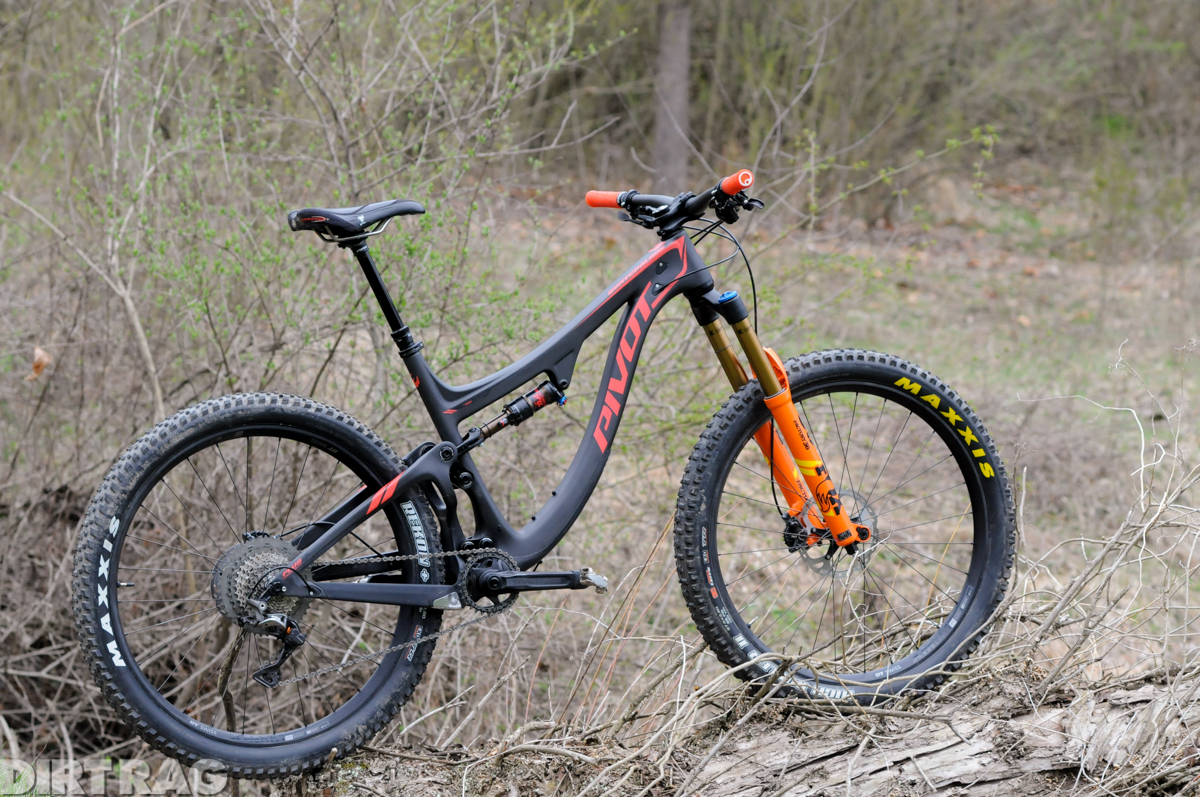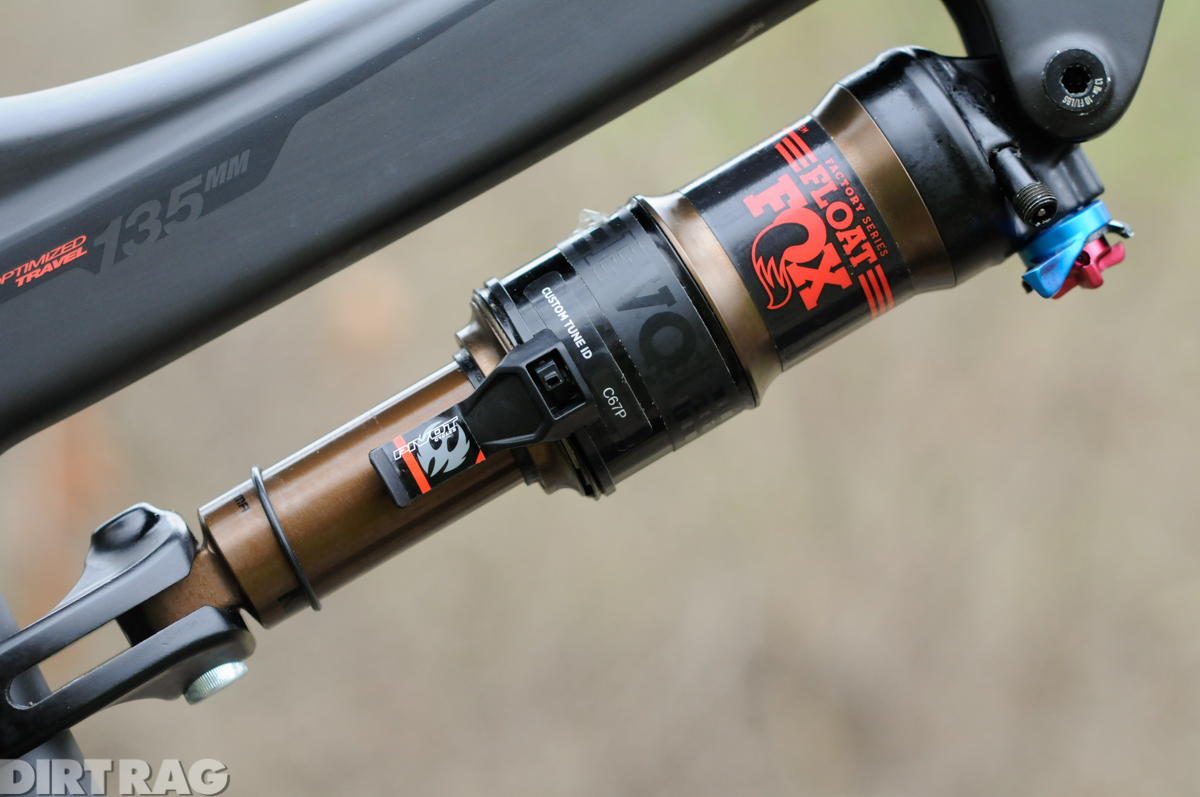Review: Pivot Switchblade Pro XT/XTR 1x
Originally posted on July 24, 2017 at 1:36 amTester: Eric McKeegan
Age: 43
Height: 5’11”
Weight: 165 lbs.
Inseam: 32”
At first glance, the Pivot Switchblade doesn’t seem to be much different than bikes with similar travel numbers and 29/27plus wheel compatibility. But look closely and you’ll start to see a lot of small differences that add up to a compelling machine. Those differences might even offer a look into the future of longer-travel big-wheeled bikes.

The Bike
Starting at the back of the bike, the Switchblade has the shortest chainstays (16.9 inches) for any bike in this class. It also has clearance for 27.5×3.25 or 29×2.4 tires. To top it off, the Switchblade can also run a front derailleur, even with the biggest tires. The catch? A 157 mm rear hub. This isn’t a new standard, but rather a further development of current standards. The 157 “Super Boost Plus” hub is the same axle spacing as downhill bikes, but the hub flanges are spaced farther apart to increase wheel stiffness. The wider rear hub needs a 56 mm chainline compared to 52 mm for 148 rear hubs. Quite a few Boost cranks will work with a different offset chainring, but the only double crank currently available is a Race Face. Pivot’s team riders are using stock Shimano Boost single-ring cranks with a 52 mm chainline, although this limits chainrings to a maximum of 32 teeth.
While that all might sound complicated, there is already a selection hubs out there with the wider flange spacing (DT, Industry Nine, SRAM), and that wider rear hub is what allows for shorter chainstays, wide tires, a front derailleur and the linkages that make dw-link bikes work so well. On a side note: Hey, Dave Weagle, can we start capitalizing the “dw” in dw-link? It still pains me, after all these years, to not capitalize a proper name. Unless it is Edward Estlin Cummings.

Instead of a longer-travel fork or an adjustable linkage to adapt to 29 inch or the shorter 27plus tires, Pivot opted for a swap from a zero stack to a 17 mm external lower headset cup. This raises the bottom bracket and slackens the head and seat angles. Pivot doesn’t try to dictate how to run this bike and seems to push experimentation with wheel sizes, headset cups and forks up to 160 mm in travel. I always rode the bike with the 17 mm cup and a 150 mm fork, regardless of wheel size.
Pivot makes this bike all the way down to an extra small frame. All sizes but the XS have two bottle mounts, although one is under the down tube. The internal cable routing is quiet, and the inserts can be configured for various drivetrain, brake and dropper setups. A Di2 battery can be stored inside the frame for a very clean look. I was disappointed by the loop of housing under the bottom bracket, but other than that, this is a very clean machine.

The Ride
This bike arrived with the baggage of a few “Bike of the Year” awards from other media outlets, and my contrarian nature immediately tried to find reasons to prove my media colleagues incorrect. That proved to be a difficult task.
As expected, the dw-link suspension pedaled extremely well. The rear suspension never bottomed harshly, but it did seem to move through the midstroke quickly. Dialing in more low-speed compression in the open position helped. I wouldn’t call it wallow, but I wouldn’t call it a supportive midstroke. The lockouts on both ends were very firm, something I appreciate for pavement to and from the trails.

For riders moving from an older bike to a Switchblade, the seat angle will feel normal, but I noticed its slackness when climbing. But the more rearward weight bias made this bike easy to wheelie and hop, and it was less of a chore to hustle through slow and tight sections of trail than its longer competitors.
The Fox 36 first struck me as overkill for this bike, but I soon forgot this is the biggest trail fork Fox makes. With a second volume spacer and 70 psi in the air spring, I pointed this bike at the worst chunk I could find. I was able to run the fork wide open with a few clicks of low-speed compression, and only went to full lock-out for pavement; I found little need for the middle “platform” position. I did use the rear shock’s platform setting more often on rolling trails, but even that could be left fully open without losing much pedaling performance.
My favorite trails are a mix of everything that I love about mountain biking: rough and technical, fast and flowing, slow and off balance. The Switchblade manages to find a balance in all of these conditions, even though they often require very different handling characteristics. At lower speeds and rolling technical terrain, the Switchblade manages to make itself feel much smaller than I expected. Slipping in between tight trees and over downed logs was squarely in the “fun” realm and resulted in me grabbing this bike more often that I would have expected, even for short local rides where I would normally prefer smaller bikes. Unlike some other bigger 29ers, this bike didn’t need to be WFO all the time to feel at home. It won’t be mistaken for a cross-country bike, but it can hustle when needed.

While not quite as planted in the chunky stuff as some longer bikes I’ve ridden, I certainly wasn’t afraid to open it up and get fast and loose. I appreciated the fact that I could more easily make a correction to my line choice; a yank on the bars and a toss of the hips gets the Switchblade reoriented on the trail with a minimum of fuss.
For the fast and flowing bits, the Switchblade felt very much at home, feeling very natural in berms and in the air. For the speeds I am capable of reaching, there was still something to be unlocked on the top end of this bike, but it never gave the feeling that it was bored if I wasn’t WFO all the time.
This is also the first 29/27plus bike I actually liked better in plus mode. Perhaps it was the swap from the stock Rekon on the front to a High Roller II, which is fast becoming a favorite tire for loose and sloppy conditions. I was surprised the Rekons weren’t the same 3C rubber that comes with the 29×2.35 High Rollers, but it seems the rough and rocky trails around Pivot’s Phoenix offices were chewing up and spitting out the 120 tpi casing found on the Rekons with 3C rubber. On a bike like this, erring on the side of durable tires seems like a good idea. That isn’t to say this bike feels even remotely bad as a 29er, but in the late winter to early spring conditions, including a really excellent ride in about 4 inches of fresh snow, the plus tires really won me over. If you are going to sink this kind of money into a bike, it is worth ordering both sets of wheels to go with it.

Conclusions
If I was suddenly given the ability to take the summer off to road trip and ride anywhere I wanted in the U.S. and Canada, but could only take one bike, this would be it. The Switchblade is good enough to bail me out of bad line choices in the steeps of BC, blast rocky descents in the Rockies, find some flow on the rocks of Virginia and North Carolina, and bust out all-day epics anywhere I wanted. I’m more than willing to deal with the slight weirdness of a 157 rear hub to take advantage of the benefits.
Price: $6,399
Sizes: XS, S, M, L (tested), XL